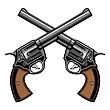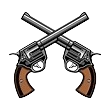About Revolver Guns: History, Design, and Uses
Revolver guns, often simply called revolvers, are a type of repeating firearm that utilizes a multi-chambered revolving cylinder to hold ammunition. Unlike semi-automatic pistols that automatically eject and load the next round, revolvers require the shooter to manually cock the hammer or press the trigger (in double-action mode) to rotate the cylinder and bring the next chamber into alignment with the barrel for firing. This distinct mechanism and design have made revolvers iconic in the history of firearms, offering a blend of reliability, simplicity, and versatility.
Historical Overview of Revolver guns
The revolver’s history dates back to the early 19th century, with the most significant development attributed to Samuel Colt. He patented his revolver design in 1836, fundamentally changing the way firearms were used. Colt’s invention allowed for multiple rounds to be fired without the need to reload after each shot, a revolutionary advantage at the time. Revolvers played a significant role in the expansion of the American West and were widely used in the American Civil War. Over the years, they have been employed in various military, law enforcement, and civilian contexts worldwide.
Design and Operation of Revolver guns
The basic components of a revolver include the frame, cylinder, barrel, and action. The cylinder, which houses the ammunition, can typically hold five to nine rounds, depending on the caliber and design.
There are two primary types of revolver actions:
- Single-Action Revolvers: Require the hammer to be manually cocked before each shot, which also rotates the cylinder. The trigger performs a single action, releasing the hammer.
- Double-Action Revolvers: Allow for the hammer to be cocked and released by a single pull of the trigger, although they can also be operated in single-action mode by manually cocking the hammer.
Revolvers are chambered in various calibers, from small .22 caliber rounds suitable for target shooting and small game hunting, to powerful .44 Magnum cartridges designed for hunting and self-defense.
Advantages and Disadvantages
Advantages
- Reliability: Revolvers are known for their reliability. They have fewer moving parts than semi-automatic pistols, which can translate to fewer malfunctions.
- Simplicity: Their operation is straightforward, making them easy to use after minimal training.
- Versatility: Revolvers can fire a wide range of ammunition types within the same caliber, including less powerful ‘special’ rounds up to full-power ‘magnum’ rounds.
Disadvantages
- Capacity: They generally hold fewer rounds than semi-automatic pistols.
- Reload Time: Reloading can be slower, especially under stress without practice or the use of speed loaders.
- Size and Weight: Especially with larger caliber models, revolvers can be bulkier and heavier.
Uses
Revolvers serve a wide range of purposes:
- Law Enforcement and Military: Although semi-automatic pistols have largely supplanted revolvers in military and police roles, some units and individual officers still prefer revolvers for their reliability and simplicity.
- Self-defense: Many people choose revolvers for personal protection due to their ease of use and reliability.
- Recreational Shooting and Hunting: Revolvers are popular among target shooters and hunters. Their accuracy and the availability of powerful calibers make them suitable for hunting small to large game.
Conclusion
Revolvers embody a significant part of firearm history and continue to be favored by many for their reliability, simplicity, and the tactile experience they offer. Whether used for sport, hunting, defense, or as a piece of historical fascination, revolvers maintain a revered place in the world of firearms, illustrating the enduring legacy of their design and functionality.

